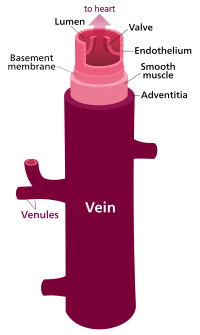
Photo from wikipedia
Objectives Predicting the risk of rupture of small intracranial aneurysms remains challenging. The irregular pulsation of aneurysms detected by four-dimensional CT angiography (4D-CTA) could be an imaging marker of aneurysm… Click to show full abstract
Objectives Predicting the risk of rupture of small intracranial aneurysms remains challenging. The irregular pulsation of aneurysms detected by four-dimensional CT angiography (4D-CTA) could be an imaging marker of aneurysm vulnerability. We aimed to investigate the association of irregular pulsation with small aneurysm rupture. Materials and Methods This was a prospective study on intracranial aneurysms detected by 4D-CTA from October 2017 to January 2020. A total of 242 consecutive patients with 316 aneurysms were enrolled. Irregular pulsation was defined as a temporary focal protuberance on more than 3 consecutive frames of the 20 phases in the RR interval. Small aneurysms were defined as those <7 mm. Univariate and multivariate analyses were performed to determine the independent predictors of small aneurysm rupture. Results A total of 169 patients with 217 small intracranial aneurysms were included. Fourteen (6.5%) of the aneurysms had ruptured, and 77 (35.5%) had irregular pulsation. There were no significant differences in age, sex, hypertension, smoking, diabetes, drinking, or hyperlipidemia between the ruptured and unruptured aneurysm groups. The univariate analysis showed that smaller vessel size (p = 0.008), larger size ratio (p = 0.003), larger aspect ratio (p = 0.006), larger flow angle (p = 0.001), large vessel angle (p = 0.004), middle cerebral artery aneurysms (p = 0.046), anterior cerebral artery/posterior communicating artery/posterior circulation aneurysm (p = 0.006), irregular aneurysm (p = 0.001), and t presence of irregular pulsation (p = 0.001) were associated with small aneurysm rupture. The multivariate analysis showed that the presence of irregular pulsation (p = 0.003), anterior cerebral artery/posterior communicating artery/posterior circulation aneurysms (p = 0.014), and larger flow angle (p = 0.006) was independently associated with aneurysm rupture. Multivariate analysis of predictors of the irregular pulsation of small aneurysms showed that the aneurysm rupture (p = 0.022), irregular aneurysm (p < 0.001), and large size ratio (p = 0.005) were independently associated with the presence of irregular pulsation. Conclusions The ruptured small aneurysms more often had irregular pulsation. The irregular pulsation was independently associated with aneurysm rupture and may help evaluate the risk of rupture of small intracranial aneurysms.
Journal Title: Frontiers in Neurology
Year Published: 2022
Link to full text (if available)
Share on Social Media: Sign Up to like & get
recommendations!